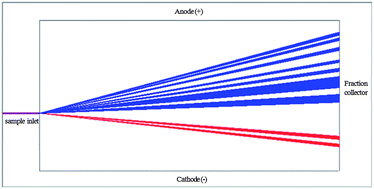Mathematical model and dynamic computer simulation on free flow zone electrophoresis†
Abstract
In this paper, a mathematical model was proposed for calculating physico-chemical parameters and simulating the separation process of solutes in free-flow zone electrophoresis (FFZE). Computer software was developed and implemented in a Delphi XE2 environment based on the model, which comprises zone electrophoresis, electrolyte solution, hydrodynamics and diffusion as well as conversion equations. The simulation results reveal that (i) the software is capable of simulating a dynamic process of FFZE properly; (ii) the software can simulate operation parameters (e.g., electric field, flow rate and pH value) for experimental optimization; (iii) the simulator is able to display the final electropherogram of numerous analytes in FFZE; and (iv) the electropherogram of FFZE can be automatically converted to that of capillary zone electrophoresis. In order to verify the rationality and reliability of this software, the relevant experiments were conducted and further compared with the simulations. The comparisons demonstrated the high agreement between the simulations and the experiments as well as those cited from the relevant references. In addition, effective mobility, diffusion coefficient and concentration of solutes can be conveniently gained via the software. The developed mathematical model and designed software have evident significance for the optimization of experimental conditions and basic physico-chemical parameters in FFZE.


 Please wait while we load your content...
Please wait while we load your content...